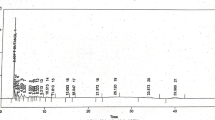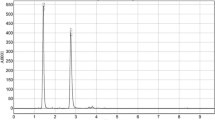Abstract
The aim of this paper was to develop and validate a method of ultra high-performance liquid chromatography coupled with diode array detector (UHPLC-DAD), which allows quantifying simultaneously 19 phenolic compounds in aromatic plants. Twenty-one fresh and dried aromatic plants were extracted with methanol before their UHPLC-DAD analysis. The method was validated regarding specificity, working range, linearity, limit of detection (LOD) and quantification (LOQ), precision, and accuracy. The developed method allows detecting and quantifying the phenolic compounds at low concentrations (LOD < 0.15 μg/mL, except for carnosol and carnosic acid). The relative standard deviation obtained was lower than 5.73 and 8.75%, for repeatability and intermediate precision, respectively. The proposed method is straightforward and sensitive, with good precision and accuracy. Dried thyme presented the highest diversity of phenolic compounds and rosmarinic acid was present in most of the samples. This analytical tool is a valid alternative to conventional methods to quantify phenolic compounds in aromatic plants or in their extracts.


Similar content being viewed by others
References
Akhtar N, Ihsan-ul-Haq, Mirza B (2015) Phytochemical analysis and comprehensive evaluation of antimicrobial and antioxidant properties of 61 medicinal plant species. Arab J Chem. doi:10.1016/j.arabjc.2015.01.013
Aronne G, De Micco V, Scala M (2006) Effects of relative humidity and temperature conditions on pollen fluorochromatic reaction of Rosmarinus officinalis L. (Lamiaceae). Protoplasma 228:127–130. doi:10.1007/s00709-006-0173-3
Babovic N, Djilas S, Jadranin M et al (2010) Supercritical carbon dioxide extraction of antioxidant fractions from selected Lamiaceae herbs and their antioxidant capacity. Innov Food Sci Emerg Technol 11:98–107. doi:10.1016/j.ifset.2009.08.013
Bentayeb K, Rubio C, Batlle R, Nerín C (2007) Direct determination of carnosic acid in a new active packaging based on natural extract of rosemary. Anal Bioanal Chem 389:1989–1996. doi:10.1007/s00216-007-1570-y
Bianchin, M; Carpes ST (2012) Propriedades antioxidante e antimicrobiana dos extratos etanólicos e óleo essencial de Rosmarinus officinalis. Available on: http://conferencias.utfpr.edu.br/ocs/index.php/sicite/2012/paper/viewFile/634/427. Accessed 07 Dec 2016
De Melo LV, Sawaya ACHF (2015) UHPLC–MS quantification of coumarin and chlorogenic acid in extracts of the medicinal plants known as guaco (Mikania glomerata and Mikania laevigata). Rev Bras Farmacogn 25:105–110. doi:10.1016/j.bjp.2015.02.005
Dorman HJD, Bachmayer O, Kosar M, Hiltunen R (2004) Antioxidant properties of aqueous extracts from selected Lamiaceae species grown in Turkey. J Agric Food Chem 52:762–770. doi:10.1021/jf034908v
Durić K, Kovač-Bešović E, Nikšić H, Sofić E (2013) Antioxidant activity of water extracts and essential oil of Artemisa dracunculus L., Asteraceae. Med J 19:94–99
Erkan N, Ayranci G, Ayranci E (2008) Antioxidant activities of rosemary (Rosmarinus officinalis L.) extract, blackseed (Nigella sativa L.) essential oil, carnosic acid, rosmarinic acid and sesamol. Food Chem 110:76–82. doi:10.1016/j.foodchem.2008.01.058
Farzaneh V, Carvalho IS (2015) A review of the health benefit potentials of herbal plant infusions and their mechanism of actions. Ind Crop Prod 65:247–258. doi:10.1016/j.indcrop.2014.10.057
Fecka I, Turek S (2008) Determination of polyphenolic compounds in commercial herbal drugs and spices from Lamiaceae: thyme, wild thyme and sweet marjoram by chromatographic techniques. Food Chem 108:1039–1053. doi:10.1016/j.foodchem.2007.11.035
Gaweł-Bȩben K, Bujak T, Nizioł-Łukaszewska Z et al (2015) Stevia rebaudiana Bert. leaf extracts as a multifunctional source of natural antioxidants. Molecules 20:5468–5486. doi:10.3390/molecules20045468
Ghanta S, Banerjee A, Poddar A, Chattopadhyay S (2007) Oxidative DNA damage preventive activity and antioxidant potential of Stevia rebaudiana (bertoni) bertoni, a natural sweetener. J Agric Food Chem 55:10962–10967. doi:10.1021/jf071892q
Herrero M, Plaza M, Cifuentes A, Ibáñez E (2010) Green processes for the extraction of bioactives from rosemary: chemical and functional characterization via ultra-performance liquid chromatography-tandem mass spectrometry and in-vitro assays. J Chromatogr A 1217:2512–2520. doi:10.1016/j.chroma.2009.11.032
Hossain MB, Barry-Ryan C, Martin-Diana AB, Brunton NP (2010) Effect of drying method on the antioxidant capacity of six Lamiaceae herbs. Food Chem 123:85–91. doi:10.1016/j.foodchem.2010.04.003
Hossain MB, Barry-Ryan C, Martin-Diana AB, Brunton NP (2011) Optimisation of accelerated solvent extraction of antioxidant compounds from rosemary (Rosmarinus officinalis L.), marjoram (Origanum majorana L.) and oregano (Origanum vulgare L.) using response surface methodology. Food Chem 126:339–346. doi:10.1016/j.foodchem.2010.10.076
International Conference on Harmonisation (ICH) (1995) Guidance for Industry: Q2A Text on validation of analytical procedures. Rockville, MD: U.S. Dept. of Health and Human Services, Food and Drug Administration, Center for Drug Evaluation and Research. Available on: https://www.fda.gov/downloads/Drugs/GuidanceComplianceRegulatoryInformation/Guidances/UCM073381.pdf . Accessed 07 Dec 2016
International Conference on Harmonisation (ICH) (1996) Guidance for Industry: Q2B Validation of Analytical Procedures, Methodology. Rockville, MD: U.S. Dept. of Health and Human Services, Food and Drug Administration, Center for Drug Evaluation and Research. Available on:https://www.fda.gov/downloads/Drugs/GuidanceComplianceRegulatoryInformation/Guidances/UCM073384.pdf. Accessed 07 Dec 2016
Iranshahi M, Rezaee R, Parhiz H et al (2015) Protective effects of flavonoids against microbes and toxins: the cases of hesperidin and hesperetin. Life Sci 137:125–132
Jabri-Karoui I, Bettaieb I, Msaada K et al (2012) Research on the phenolic compounds and antioxidant activities of Tunisian Thymus capitatus. J Funct Foods 4:661–669. doi:10.1016/j.jff.2012.04.007
Justesen U, Knuthsen P (2001) Composition of flavonoids in fresh herbs and calculation of flavonoid intake by use of herbs in traditional Danish dishes. Food Chem 73:245–250. doi:10.1016/S0308-8146(01)00114-5
Kakkar S, Bais S (2014) A review on protocatechuic acid and its pharmacological potential. ISRN Pharmacol 2014:952943. doi:10.1155/2014/952943
Kaushik R, Narayanan P, Vasudevan V et al (2010) Nutrient composition of cultivated stevia leaves and the influence of polyphenols and plant pigments on sensory and antioxidant properties of leaf extracts. J Food Sci Technol 47:27–33. doi:10.1007/s13197-010-0011-7
Kazimierczak R, Hallmann E, Rembiałkowska E (2014) Effects of organic and conventional production systems on the content of bioactive substances in four species of medicinal plants. Biol Agric Hortic. doi:10.1080/01448765.2014.977948
Khaled-Khodja N, Boulekbache-Makhlouf L, Madani K (2014) Phytochemical screening of antioxidant and antibacterial activities of methanolic extracts of some Lamiaceae. Ind Crops Prod 61:41–48. doi:10.1016/j.indcrop.2014.06.037
Kim IS, Yang M, Lee OH, Kang SN (2011) The antioxidant activity and the bioactive compound content of Stevia rebaudiana water extracts. LWT Food Sci Technol 44:1328–1332. doi:10.1016/j.lwt.2010.12.003
Kosar M, Dorman HJD, Bachmayer O et al (2003) An improved on-line HPLC-DPPH* method for the screening of free radical scavenging compounds in water extracts of lamiaceae plants. Chem Nat Compd 39:161–166. doi:10.1023/A:1024853628326
Martins N, Barros L, Santos-Buelga C et al (2015) Decoction, infusion and hydroalcoholic extract of cultivated thyme: antioxidant and antibacterial activities, and phenolic characterisation. Food Chem 167:131–137. doi:10.1016/j.foodchem.2014.06.094
Miliauskas G, Venskutonis PR, Van Beek TA (2004) Screening of radical scavenging activity of some medicinal and aromatic plant extracts. Food Chem 85:231–237. doi:10.1016/j.foodchem.2003.05.007
Miron TL, Plaza M, Bahrim G et al (2011) Chemical composition of bioactive pressurized extracts of Romanian aromatic plants. J Chromatogr A 1218:4918–4927. doi:10.1016/j.chroma.2010.11.055
Monti D, Tampucci S, Chetoni P et al (2011) Permeation and distribution of ferulic acid and its α-cyclodextrin complex from different formulations in hairless rat skin. AAPS PharmSciTech 12:514–520. doi:10.1208/s12249-011-9609-y
Muanda FN, Soulimani R, Diop B, Dicko A (2011) Study on chemical composition and biological activities of essential oil and extracts from Stevia rebaudiana Bertoni leaves. LWT Food Sci Technol 44:1865–1872. doi:10.1016/j.lwt.2010.12.002
Papageorgiou V, Mallouchos A, Komaitis M (2008) Investigation of the antioxidant behavior of air- and freeze-dried aromatic plant materials in relation to their phenolic content and vegetative cycle. J Agric Food Chem 56:5743–5752. doi:10.1021/jf8009393
Proestos C, Chorianopoulos N, Nychas G.-J. E, Komaitis M (2005) RP-HPLC Analysis of the Phenolic Compounds of Plant Extracts. Investigation of Their Antioxidant Capacity and Antimicrobial Activity. J Agric Food Chem 53:1190–1195. doi: 10.1021/jf040083t
Ribeiro-Santos R, Carvalho-Costa D, Cavaleiro C et al (2015) A novel insight on an ancient aromatic plant: the rosemary (Rosmarinus officinalis L.) Trends Food Sci Technol 45:355–368. doi:10.1016/j.tifs.2015.07.015
Ribeiro-Santos R, Andrade M, Madella D et al (2017) Revisiting an ancient spice with medicinal purposes: cinnamon. Trends Food Sci Technol 62:154–169. doi:10.1016/j.tifs.2017.02.011
Roby MHH, Sarhan MA, Selim KAH, Khalel KI (2013) Evaluation of antioxidant activity, total phenols and phenolic compounds in thyme (Thymus vulgaris L.), sage (Salvia officinalis L.), and marjoram (Origanum majorana L.) extracts. Ind Crop Prod 43:827–831. doi:10.1016/j.indcrop.2012.08.029
Shan B, Cai YZ, Sun M, Corke H (2005) Antioxidant capacity of 26 spice extracts and characterization of their phenolic constituents antioxidant capacity of 26 spice extracts and characterization of their phenolic constituents. J Agric Food Chem 53:7749–7759. doi: 10.1021/jf051513y
Shivanna N, Naika M, Khanum F, Kaul VK (2013) Antioxidant, anti-diabetic and renal protective properties of Stevia rebaudiana. J Diabetes Complicat 27:103–113. doi:10.1016/j.jdiacomp.2012.10.001
Sroka Z, Fecka I, Cisowski W (2005) Antiradical and anti-H2O2 properties of polyphenolic compounds from an aqueous peppermint extract. Zeitschrift fur Naturforsch Sect C J Biosci 60:826–832
Terpinc P, Bezjak M, Abramovič H (2009) A kinetic model for evaluation of the antioxidant activity of several rosemary extracts. Food Chem 115:740–744. doi:10.1016/j.foodchem.2008.12.033
Wang H, Provan GJ, Helliwell K (2004) Determination of rosmarinic acid and caffeic acid in aromatic herbs by HPLC. Food Chem 87:307–311. doi:10.1016/j.foodchem.2003.12.029
Wojdyło A, Oszmiański J, Czemerys R (2007) Antioxidant activity and phenolic compounds in 32 selected herbs. Food Chem 105:940–949. doi:10.1016/j.foodchem.2007.04.038
Zaouali Y, Bouzaine T, Boussaid M (2010) Essential oils composition in two Rosmarinus officinalis L. varieties and incidence for antimicrobial and antioxidant activities. Food Chem Toxicol 48:3144–3152. doi:10.1016/j.fct.2010.08.010
Zhao B, Hu M (2013) Gallic acid reduces cell viability, proliferation, invasion and angiogenesis in human cervical cancer cells. Oncol Lett 6:1749–1755. doi:10.3892/ol.2013.1632
Zheng W, Wang SY (2001) Antioxidant activity and phenolic compounds in selected herbs. J Agric Food Chem 49:5165–5170. doi:10.1021/jf010697n
Acknowledgments
This work was supported by the project PTDC/AGRTEC/3366/2012 with the acronym Rose4Pack (Biodegradable active packaging with rosemary extract (Rosmarinus officinalis L.) to improve food shelf-life) funded by the Foundation for Science and Technology (FCT) and COMPETE Program (FCOMP-01-0124-FEDER-028015). Regiane Ribeiro dos Santos (BEX 8754/14-4) is grateful for her research grant funded by the Brazilian Federal Agency for Support and Evaluation of Graduate Education (CAPES).
Author information
Authors and Affiliations
Corresponding author
Ethics declarations
Funding
This study was funded by the Foundation for Science and Technology (FCT) (PTDC/AGRTEC/3366/2012), COMPETE Program (FCOMP-01-0124-FEDER-028015), and the Brazilian Federal Agency for Support and Evaluation of Graduate Education (CAPES) (BEX 8754/14-4).
Conflict of Interest
Ana Sofia Oliveira declares that she has no conflict of interest. Regiane Ribeiro dos Santos declares that she has no conflict of interest. Fernando Ramos declares that he has no conflict of interest. Maria Conceição Castilho declares that she has no conflict of interest. Ana Sanches Silva declares that she has no conflict of interest.
Ethical Approval
This article does not contain any studies with human participants or animals performed by any of the authors.
Informed Consent
Not applicable.
Rights and permissions
About this article
Cite this article
Oliveira, A.S., Ribeiro-Santos, R., Ramos, F. et al. UHPLC-DAD Multi-Method for Determination of Phenolics in Aromatic Plants. Food Anal. Methods 11, 440–450 (2018). https://doi.org/10.1007/s12161-017-1015-y
Received:
Accepted:
Published:
Issue Date:
DOI: https://doi.org/10.1007/s12161-017-1015-y




